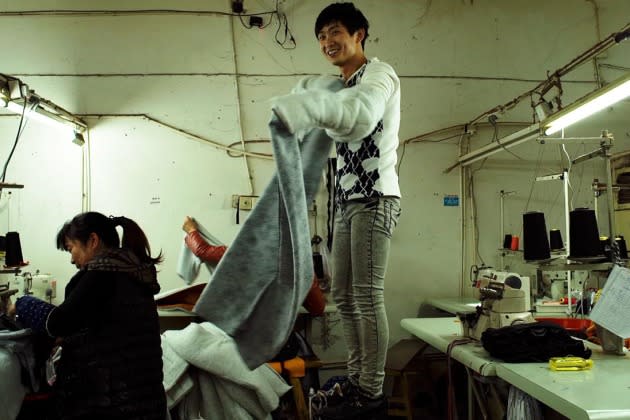‘Youth (Spring)’ Review: Wang Bing’s Absorbingly Dense and Detailed Doc Portrait of Eastern Chinese Garment Workers

The first thing anyone ever says about the work of venerated documentary filmmaker Wang Bing is that he makes fascinating but long films. Like, really, really long. His debut West of the Tracks (Tie Xi Qu), about a crumbling industrial district, screened in two different versions, one five and the other nine hours, give or take. Crude Oil — as the name might suggest, a portrait of oil workers — spanned 14 hours.
Two of his films are screening at Cannes this year — main competition entrant Youth (Spring) and special screening Man in Black — so at three and half hours and 60 minutes, respectively, in Wang terms they’re practically shorts. Kvetching about length aside, Youth (the parenthetical subtitle Spring heralds a projected series of films) is consistently engaging, even if it’s not always easy to see what the whole package is trying to say that couldn’t be said with more brevity. Like Frederick Wiseman, Wang is a lofty filmmaking doc deity who moves in mysterious, glacial ways, but one who sometimes performs miracles.
More from The Hollywood Reporter
Like Wang’s relatively recent doc Bitter Money (2016, a tight 156 minutes), Youth (Spring) embeds itself among workers in the garment industry of Eastern China. For most of its running time, the film unfolds in a few streets in a very specific industrial area called Zhili, within the prefecture of Huzhou in Zhejian province. For centuries, this region has been famous for its silk making and textile production, well before the industrial revolution kicked off in Europe. Garment making and its ancillary trades continue to dominate the region’s economy, but they do things a little differently in Zhili.
As explained in fascinating detail in the film’s press notes (and sadly hardly at all in the film, though knowing this would enhance viewer interest), this is one of those very few zones where, instead of the all-powerful State, small family traders run a sub-section of the garment industry, one producing mostly children’s clothes for the domestic market. There are thousands of workshops in the area, generically named Workshop 110, 76 or whatever, often run by actual mom and pop sole traders who negotiate with the workforce over how much machinists will be paid by the piece, depending on how intricate it is to construct. (Incidentally, this system has operated in varying ways for hundreds of years in several historical textile hubs, including the northeast of the United States back when that region had a thriving textile industry.)
Much of the film, especially in its later hours, is given over to observing these delicate boss-worker negotiations as they haggle back and forth — sometimes surrounded by bystanders from both sides with vested interests — over whether a garment is worth 11 yuan or 10 a piece. (10 Chinese Yuan is worth $1.42 approximately.) Wang isn’t interested in the bigger picture of whether that’s a fair price in the context of the world economy. (Obviously, it’s a pitiful amount compared to what a U.S. worker would earn for the same piece.) Instead, this is really about the drama of the interactions; even if you don’t speak Mandarin or the local dialects, you can tell that some of the younger workers, some in their late teens, are terrible negotiators when pitted against the local bosses watching their margins with a hawkish eye.
This very Wiseman-esque attention to granular detail and how it reveals larger truths about communities and institutions is at the essence of Wang’s practice here. In a way, all of human life is here in these filthy, cluttered, teeming workshops. As the sewists work the industrial machinery for sometimes 18-hour stretches, they bicker, flirt, debate, giggle, tease and taunt one another. In the early running, a fist fight breaks out between two young men when one throws an empty thread spool at the other, and a female colleague rightly describes it as a silly cockfight. Later, one young man tries to reconcile with his ex as she runs piece after piece through a serger machine.
I saw the film while sitting next to Time‘s Stephanie Zacharek, like me a passionate home sewist, and we both said afterwards that we kept expecting someone to slice a finger off on a serger, especially given how fast some of the workers zip their pieces through their machines. Indeed, the film sometimes feels like a disaster movie in the making as the workers often smoke while sewing, risking a conflagration at any moment, particularly since they’re working with so many flammable synthetic fibers. (One man complains about how horrible they are to work with these days.)
On the other hand, those who understand the skill involved in what these people do could be a key target demographic for the film. There is something dazzling, almost soothing like an ASMR video, about watching them line up and seam pant leg after pant leg without a single pin, and score lines of straight stich onto quilted fiber sandwiches for outerwear. On the back of intensified interest in the environmental impact of the textile industry worldwide and the industry’s treatment of workers in developing nations, there has been a boom in films, both documentary and fictional, about garment workers. This is a major contribution to this sub-genre.
And yet it’s also an outsider in that there’s no polemic here about equity or injustice. Wang is more interested in the people themselves in all their particolored, mismatched, designer-knockoff finery. It’s up to us viewers to draw deeper conclusions. And at a film festival sometimes more concerned about who’s wearing what on the red carpet, this provides a sobering reflection on another aspect of the world of fashion.
Best of The Hollywood Reporter